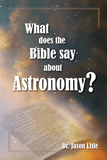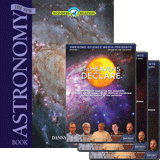
The Newest Finding on the Expansion of the Universe
Introduction
The latest measure of the Hubble constant (H0) recently made headlines. Adam Riess and a team of collaborators found a value of 74.03 km/s/Mpc,1 a bit larger than their previous measurement of 73.24 km/s/Mpc for H0. The Hubble constant is the basic datum about cosmology, so its value is of supreme importance in developing any cosmological model. Many people have questions about this new study, so I’ll explain some of the technical details.
What Did the New Study Find?
Edwin Hubble is generally credited with discovering the expansion of the universe almost a century ago. Nearly all galaxies have redshifts in their spectra, indicating that their distances are increasing. Hubble found that galaxy redshift and distance are related: the greater the distance, the greater the redshift. We call this relationship the Hubble law. The simplest interpretation of the Hubble law is that the universe is expanding. The Hubble constant, the slope of galaxy redshift versus distance, measures the rate of that expansion. While galaxy redshifts are relatively straightforward to measure, distances are not, because there are many uncertainties in measuring the distances to galaxies.
One of the most important methods for measuring galaxy distances involves Cepheid variables. Cepheids are giant and supergiant stars that pulsate with regular periods. As Cepheids pulsate, their sizes change, and, to a lesser extent, their temperatures vary too. The brightness of a star depends upon both size and temperature, so over a cycle, a Cepheid’s brightness noticeably changes. More than a century ago astronomers realized that the period over which a Cepheid varied was related to the Cepheid’s average brightness—the longer the period, the brighter the Cepheid. Astronomers call this the Cepheid period-luminosity relation. How bright a Cepheid appears also depends upon the Cepheid’s distance. Therefore, if we can calibrate the absolute brightness of Cepheid variables, we can use them to find distances. Since Cepheids are exceedingly bright stars, we can see them in nearby galaxies, and they provide an important first step in determining distances of galaxies, and hence the Hubble constant. Alas, precise calibration of Cepheid brightness is not easy.
The recent study headed up by Riess used the Hubble Space Telescope (HST) to observe 70 Cepheids in the Large Magellanic Cloud (LMC), a satellite galaxy of our Milky Way galaxy to unprecedented accuracy. A few years ago, a concentrated collaboration of astronomers observed eclipsing binary stars in the LMC. A binary star is a system of two stars orbiting one another under the influence of their mutual gravity. If we lie near the orbital plane of a binary star, then the two stars undergo eclipses of one another, so we call such systems eclipsing binary stars. By the way, I’ve been studying eclipsing binary stars for four decades. Since the duration of the eclipses depends upon the sizes of the stars, we can find the sizes of the stars in an eclipsing binary system. Recall that the brightness of a star depends upon its size and temperature. Stellar temperature can be directly measured, so astronomers can determine the brightness of eclipsing binary stars. By comparing the observed brightness of the eclipsing binaries in the LMC to the known brightness, the collaboration of astronomers was able to determine the distance to the LMC to be 163,000 light years. Riess’ team used this distance and their observations of the 70 Cepheids in the LMC to calibrate the Cepheid period-luminosity relation. This new calibration was used to determine the distances of nearby galaxies, which in turn was used to calibrate other methods of finding how far away even more distant galaxies were (this sort of boot-strapping process is common in finding astronomical distances). With more precisely determined distances to many galaxies, Riess and his team were able to find the new value for H0.
What Does This Mean?
Assuming that the big bang model is correct, the Hubble constant determines the age of the universe. A larger value for H0 results in a younger age for it. Riess estimated his new value for H0 yields an age of 12.5–13 billion years. This is at variance with the estimated age of 13.8 billion years (plus or minus 1%) that has prevailed for more than a decade. But this older age calculation relied critically upon the other method of determining H0. So, which one is correct?
Oddly enough, many astronomers think that both values for the Hubble constant are correct. At least, no one can see how either one is wrong. This has suggested to many cosmologists that this discrepancy may be the result of some new, yet unknown, physics. Two decades ago, Riess, Saul Perlmutter, and Brian Schmidt produced evidence that the value of H0 was increasing, indicating that the rate of expansion in the universe is accelerating. The three shared the Nobel Prize in Physics for their discovery. What is driving this acceleration in the universe? Most physicists believe that a force called dark energy is at work. If real, dark energy would require the existence of a field permeating the universe. That would be entirely new physics, but the details have yet to be worked out. Similarly, many cosmologists think that this new finding may signal another previously unknown type of physics.
If the big bang model is correct, then these two independent measures of H0 ought to be the same, but they aren’t.
As I noted in the introduction, this new value of the Hubble constant is slightly larger than the one that Riess and collaborators had found earlier. What is the significance of this new value of H0? Last year I commented on Riess’ earlier value for H0 and how it was at variance with the value of H0 determined by applying the big bang model to the cosmic microwave background. The new value for the Hubble constant increases the discrepancy. And the discrepancy is statistically significant, meaning that the likely errors of the two measurements do not overlap. This is shaping up as a crisis in cosmology. If the big bang model is correct, then these two independent measures of H0 ought to be the same, but they aren’t. Which one is correct? As I opined last year, Riess’ measurement is directly observable, while the value of H0 derived from the CMB is highly model dependent, with that model being the big bang. This discrepancy likely indicates that there is something seriously wrong with the big bang model.
Of course, for biblical creationists, that is a no-brainer. We know from Scripture that the universe did not begin in a big bang, so the big bang model is false. Therefore, we would reject the value of H0 determined from the CMB. The Hubble law appears to be a characteristic of the universe as it exists today, so creationists have no problem accepting it, and ought not to have a problem with Riess’ newly measured value for the Hubble constant. What the Hubble law means in the biblical creation model is much debated by creation scientists. Stay tuned.
Footnotes
- The units of the Hubble constant are kilometers per second (km/s) per megaparsec (Mpc). The parsec is the standard unit of distance astronomers use beyond the solar system. A parsec is equal to 3.26 light years, or 3.1 x 1016 meters, or 1.9 x 1013 miles. A megaparsec is a million parsecs. As you can see, these numbers are staggering, hence the need to define such large units.
Recommended Resources

Answers in Genesis is an apologetics ministry, dedicated to helping Christians defend their faith and proclaim the good news of Jesus Christ.
- Customer Service 800.778.3390
- © 2024 Answers in Genesis




